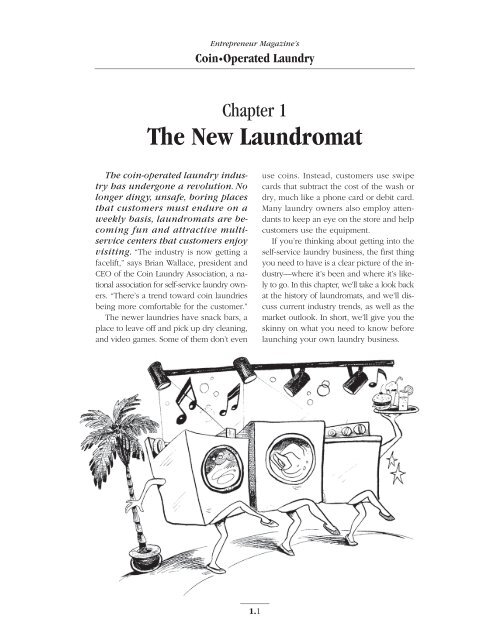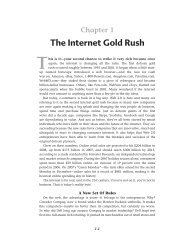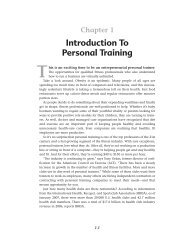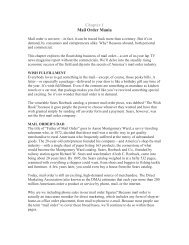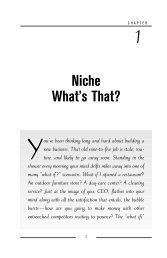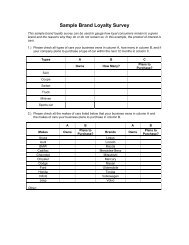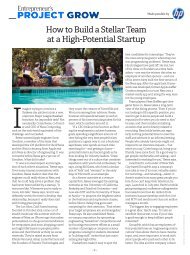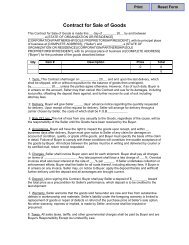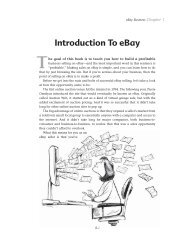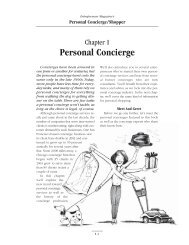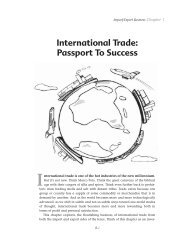The New Laundromat - Entrepreneur.com
The New Laundromat - Entrepreneur.com
The New Laundromat - Entrepreneur.com
You also want an ePaper? Increase the reach of your titles
YUMPU automatically turns print PDFs into web optimized ePapers that Google loves.
<strong>The</strong> coin-operated laundry industry<br />
has undergone a revolution. No<br />
longer dingy, unsafe, boring places<br />
that customers must endure on a<br />
weekly basis, laundromats are be<strong>com</strong>ing<br />
fun and attractive multiservice<br />
centers that customers enjoy<br />
visiting. “<strong>The</strong> industry is now getting a<br />
facelift,” says Brian Wallace, president and<br />
CEO of the Coin Laundry Association, a national<br />
association for self-service laundry owners.<br />
“<strong>The</strong>re’s a trend toward coin laundries<br />
being more <strong>com</strong>fortable for the customer.”<br />
<strong>The</strong> newer laundries have snack bars, a<br />
place to leave off and pick up dry cleaning,<br />
and video games. Some of them don’t even<br />
<strong>Entrepreneur</strong> Magazine’s<br />
Coin•Operated Laundry<br />
Chapter 1<br />
<strong>The</strong> <strong>New</strong> <strong>Laundromat</strong><br />
1.1<br />
use coins. Instead, customers use swipe<br />
cards that subtract the cost of the wash or<br />
dry, much like a phone card or debit card.<br />
Many laundry owners also employ attendants<br />
to keep an eye on the store and help<br />
customers use the equipment.<br />
If you’re thinking about getting into the<br />
self-service laundry business, the first thing<br />
you need to have is a clear picture of the industry—where<br />
it’s been and where it’s likely<br />
to go. In this chapter, we’ll take a look back<br />
at the history of laundromats, and we’ll discuss<br />
current industry trends, as well as the<br />
market outlook. In short, we’ll give you the<br />
skinny on what you need to know before<br />
launching your own laundry business.
LAUNDROMAT RENAISSANCE<br />
<strong>The</strong> coin-operated laundry industry is<br />
changing in response to several trends currently<br />
impacting the business. <strong>The</strong> first is<br />
that, for most of us, meeting the demands<br />
of work and our personal lives leads to a<br />
time crunch—there just aren’t enough hours<br />
in the day to ac<strong>com</strong>plish everything we<br />
would like to. Laundry owners are capitalizing<br />
on this reality by offering their customers<br />
time-saving convenience in the form<br />
of wash-and-fold (drop-off service) and drycleaning<br />
service. Some are even picking up<br />
laundry from customers’ homes and delivering<br />
it back to them clean and folded.<br />
In addition, owners have realized that<br />
they can maximize their profits by providing<br />
customers with access to multiple services.<br />
Since they’re paying a set amount of<br />
rent on their <strong>com</strong>mercial space, they might<br />
as well use that space to its fullest potential.<br />
Many owners around the country are serving<br />
food, renting mailboxes and offering<br />
free internet access. Because the new laundries<br />
are bigger than in the past—often<br />
3,000 or 4,000 square feet—overhead is<br />
higher, and owners are looking for ways to<br />
cover the cost. <strong>The</strong>se additional services<br />
demand little increase in overhead because<br />
Bright Idea<br />
If you have a friend<br />
who’s a manicurist, a palm<br />
reader, a masseur, or something<br />
else that could <strong>com</strong>plement<br />
your business, ask if he or she<br />
wants to offer those services in<br />
your laundry. Your friend will<br />
benefit from the captive audience,<br />
and you may draw more<br />
business from people who want<br />
to get their nails done and their<br />
clothes washed at the same time.<br />
Chapter 1<br />
<strong>The</strong> <strong>New</strong> <strong>Laundromat</strong><br />
1.2<br />
the rent is already paid for. Customers benefit<br />
by being able to use several services all<br />
in one convenient location.<br />
Cindy Patel, who has owned Mountain<br />
Wash Laundry in Shelby, North Carolina,<br />
for a year, says that she is opening a snack<br />
bar and a minimart in her laundry. “I have<br />
a big space, 6,000 square feet,” she says,<br />
“and this will help pay for it.”<br />
Paul Partyka, editor of American Coin-<br />
Op, a magazine devoted to self-service laundries,<br />
says that Patel’s approach is the norm<br />
these days. “Trying to generate additional<br />
revenue per square foot has always been<br />
an issue,” he says. “But it’s even more so<br />
now with tighter <strong>com</strong>petition and utility bills<br />
growing. Everybody wants to squeeze as<br />
much money as possible out of their space.<br />
Looking for an extra service that will work<br />
is always on their mind.”<br />
Another trend laundry owners have recognized<br />
is that customers prefer to visit<br />
laundromats with a more pleasant atmosphere.<br />
Many laundry owners are building<br />
kids’ centers, holding music concerts, giving<br />
away coffee, and hiring attendants who are<br />
friendly and helpful. “I don’t think we’ll ever<br />
cross that threshold into making laundry<br />
fun,” Wallace says, “but we’re making it<br />
more <strong>com</strong>fortable.”<br />
Tom Leavitt, owner of Darcies Laundry<br />
in the Seattle area, opened three new stores,<br />
all of them near older, smaller laundries,<br />
most of which have since closed. Darcies<br />
offers customers a better deal: bigger stores<br />
with play areas for children and attendants<br />
on duty at all times. “Our stores are very<br />
convenient,” Leavitt says. “<strong>The</strong>y’re clean,<br />
they have a friendly environment, and they<br />
have a lot of machines, so you can get in<br />
and out of there as fast as possible.”<br />
<strong>The</strong> Good <strong>New</strong>s<br />
As the population of the United States<br />
grows, the number of renters—your main<br />
market—is likely to grow, too. Other social
phenomena, like the prevalence of twoin<strong>com</strong>e<br />
families, suggest that convenient<br />
services such as wash-and-fold will continue<br />
to grow in popularity as working<br />
parents have less time to attend to household<br />
chores like laundry.<br />
According to a survey from the Coin<br />
Laundry Association, more than half of coin<br />
laundries offer wash-and-fold. “It’s by far<br />
the number-one extra service for laundries,”<br />
says Partyka. “It’s doing well.” Partyka also<br />
notes that even people with washers and<br />
dryers at home are using self-service laundries<br />
for the sake of convenience. With the<br />
regular capacity machines used in homes,<br />
it can take quite a lot of time to do load after<br />
load—and that’s where laundromats<br />
<strong>com</strong>e in. “<strong>The</strong>y just run over to the coin<br />
laundry, use a couple of the large machines<br />
and knock it off,” he says. In other words,<br />
although the majority of laundromat customers<br />
are low- to middle-in<strong>com</strong>e renters,<br />
some laundries are tapping into higher-in<strong>com</strong>e<br />
markets by offering convenience:<br />
wash-and-fold service and large machines.<br />
In addition, office dress codes are growing<br />
increasingly less formal. And as more<br />
people wear casual clothing (which doesn’t<br />
require dry cleaning) to work and leave<br />
the nicer duds for special occasions, you<br />
<strong>Entrepreneur</strong> Magazine’s<br />
Coin•Operated Laundry<br />
Dollars And Cents<br />
According to American Coin-Op magazine, these are some typical prices<br />
that laundry owners charge for using the following equipment or services:<br />
● Top-load washer: $1.50 per load<br />
● 18-pound front-load washer: $1.75 per load<br />
● 20-pound front-load washer: $2.00 per load<br />
● 35-pound front-load washer: $3.50 per load<br />
● Dryer: $0.25 per 10 minutes<br />
● Wash-and-fold: $0.90 per pound<br />
● Vended detergent: $0.50 per box<br />
1.3<br />
may find that consumers will be making<br />
more trips to the laundromat.<br />
<strong>The</strong> Bad <strong>New</strong>s<br />
While the trends we’ve mentioned are<br />
favorable for entrepreneurs entering the<br />
laundry business, they don’t suggest that<br />
business is booming. <strong>The</strong> industry is what<br />
experts describe as a “mature market.” Save<br />
for areas that are seeing high population<br />
growth, pretty much every neighborhood<br />
that needs a laundry has one—or two or<br />
three that are <strong>com</strong>peting vigorously. In<br />
some areas of the country, there are too<br />
many laundromats already.<br />
However, there is room for new laundry<br />
owners. Many get into the business by purchasing<br />
an existing laundry and renovating<br />
it. Some also find that they can build a new<br />
laundry in an area with <strong>com</strong>peting laundries<br />
and thrive by offering a bigger store, more<br />
services and better customer relations. Another<br />
way to get into the business is to locate<br />
your store where there is the best potential<br />
need for a new laundry: in an area<br />
that’s experiencing population growth.<br />
So as you consider getting into the laundry<br />
business, keep the words “mature market”<br />
in mind. Don’t buy a store just because<br />
it’s for sale or build a store just because you
have a great idea for a new gimmick. You’ll<br />
need to be very careful to make sure there’s<br />
enough of a customer base to make your<br />
business thrive. You may be able to draw a<br />
little extra business from people who like<br />
using your store better because of its cleanliness<br />
or from people who use your washand-fold<br />
service, but the core of your business<br />
will be people who just want to get their<br />
laundry done quickly and conveniently. If<br />
there are already enough laundromats in the<br />
neighborhood to serve their needs, they’re<br />
not as likely to patronize your store.<br />
Finally, you also need to consider that<br />
getting into the laundry business requires a<br />
large initial investment. <strong>The</strong> average-size<br />
laundromat will cost you in the neighborhood<br />
of $200,000 to $500,000—whether you<br />
choose to purchase an existing laundry or<br />
build one in a retail space.<br />
THE ANNALS OF LAUNDROMATS<br />
Let’s step back for a minute to see how<br />
the self-service laundry industry got to<br />
where it is today. It all started with the first<br />
wringer washer, built in 1907. During the<br />
Depression, enterprising businesspeople<br />
started using wringer washers to operate<br />
public laundries. <strong>The</strong>se businesses were<br />
originally drop-off services, where customers<br />
left their laundry to have someone<br />
wash it for them.<br />
Later on, customers could rent the machines<br />
to use themselves. “People took<br />
wringer washers and put them in a building,”<br />
says Lionel Bogut, a laundry expert<br />
who’s been in the business for more than<br />
50 years. “<strong>The</strong>y would tap hot water to each<br />
of the washers, and people would <strong>com</strong>e in<br />
and rent them for an hour or two.”<br />
Electric washers were not produced until<br />
the late 1930s. When manufacturers eventually<br />
added coin slots to the machines in<br />
the late 1950s, true coin-operated laundries<br />
came into existence. A coin-laundry construction<br />
boom followed. <strong>The</strong>re was such<br />
Chapter 1<br />
<strong>The</strong> <strong>New</strong> <strong>Laundromat</strong><br />
1.4<br />
Fun Fact<br />
One of the earliest<br />
washing machines was<br />
designed so that you<br />
could hook it up to the<br />
engine of a Model T Ford. If you<br />
didn’t have a Model T, you could<br />
still operate it by pumping with<br />
your hand or foot.<br />
a high demand for these stores that anyone<br />
who built one was almost guaranteed a profit.<br />
<strong>The</strong> owners of coin-operated laundries<br />
didn’t need to keep their stores clean and<br />
machines working to attract customers and<br />
make a profit. As a result, many laundromats<br />
were kept in poor condition.<br />
<strong>The</strong> industry deteriorated as broken machines<br />
stayed broken, stores were left dirty,<br />
and vandals and thieves took advantage of<br />
the lack of owners’ attention. In the 1960s,<br />
however, the industry experienced a resurgence.<br />
Smart new investors realized they<br />
could do better than run-down, unattended<br />
stores and started creating spiffy new<br />
businesses. <strong>The</strong>y built larger stores, hired<br />
attendants, and added dry cleaning and<br />
clothing repair.<br />
This revitalization didn’t last long, though.<br />
During the oil crisis of the 1970s, the industry<br />
saw another downturn as energy<br />
costs cut into profits and rising interest rates<br />
scared off new investors. But the industry<br />
recovered in the 1980s, due in large part to<br />
the production of new, energy-efficient<br />
equipment by manufacturers. Since that<br />
time, the number of laundromats has steadily<br />
grown; today there are approximately<br />
35,000 laundromats countrywide.<br />
THE LAUNDROMAT LIFE<br />
If you’re planning on operating just one<br />
or two stores, you’ll be in good <strong>com</strong>pany.
Three-quarters of laundry owners own<br />
only one store, and very few have more<br />
than two. While there are no national<br />
laundry chains, a few local chains are starting<br />
to grow in various parts of the country.<br />
<strong>The</strong>se chains are still quite localized,<br />
though, and only a few consist of more<br />
than a few dozen.<br />
For a little more than half of laundry owners,<br />
operating the store(s) is their full-time<br />
job. Others take the moonlighting approach—they<br />
manage other businesses or<br />
work a day job. But more laundry owners<br />
are starting to own larger stores and more<br />
than one store. <strong>The</strong>se people are able to survive<br />
on the in<strong>com</strong>e larger stores or multiple<br />
stores generate.<br />
<strong>The</strong> amount of money you can make<br />
from a laundry varies tremendously. According<br />
to the Coin Laundry Association’s<br />
Brian Wallace, the annual gross in<strong>com</strong>e<br />
from one store can range from $30,000 to<br />
$1 million. <strong>The</strong> expenses incurred while<br />
running a store range between 65 and 115<br />
percent of the gross in<strong>com</strong>e. That means<br />
that for a store grossing $30,000 per year,<br />
<strong>Entrepreneur</strong> Magazine’s<br />
Coin•Operated Laundry<br />
1.5<br />
at best it nets $10,500 and at worst it loses<br />
$4,500. For a store grossing $1 million per<br />
year, the profit could be as high as $350,000,<br />
or there could be a loss of up to $150,000,<br />
depending on expenses.<br />
Wallace says these profit margins have<br />
less to do with the size of the store than<br />
with its owner. An owner who runs his or<br />
her store well—who keeps it clean, repairs<br />
its equipment quickly, uses energy-efficient<br />
systems and offers good customer service—<br />
will see profit margins of about 35 percent.<br />
<strong>The</strong> steady in<strong>com</strong>e that a laundry generates<br />
is a plus for many people. If you’re<br />
looking for a business that will keep the<br />
cash flowing no matter what the rest of the<br />
economy is doing, you’ve found it in laundries.<br />
Clean clothes are a necessity, not a<br />
luxury, so people are going to use laundromats<br />
no matter how the stock market<br />
is performing. <strong>The</strong> business is also fairly<br />
steady month in, month out. So unless you<br />
draw on vacationers’ dollars in a place with<br />
seasonal tourism, you’ll find that you can<br />
count on a fairly steady in<strong>com</strong>e throughout<br />
the year.<br />
Businesses Have Laundry, Too<br />
A laundry can service more than families washing their clothes and<br />
sheets. If you offer wash-and-fold, consider approaching small businesses that<br />
might need laundry done on a regular basis: hair salons, pet groomers, day<br />
spas, motels, caterers, schools and restaurants.<br />
Before you start knocking on doors, however, be sure you have your washand-fold<br />
system well-greased. And you’ll need some wheels: Commercial customers<br />
will likely want you to pick up and deliver the laundry, as they’re busy<br />
running their own enterprises. <strong>The</strong>y may also expect you to invoice them, so<br />
you’ll need to be ready to send out monthly bills.<br />
Tom Leavitt of Darcies Laundry in Seattle has been successful with his <strong>com</strong>mercial<br />
route. “<strong>The</strong>re is a niche in the market for those who need laundry services<br />
who can’t afford the really big <strong>com</strong>mercial laundries,” he says. But he cautions<br />
that the <strong>com</strong>mercial accounts take some work to build and maintain: “It<br />
takes someone out there selling constantly.”
Stat Fact<br />
According to American<br />
Coin-Op magazine,<br />
the top expenses for<br />
laundry owners include<br />
utilities, rent, employees, insurance,<br />
maintenance and parts, and<br />
loan payments.<br />
But remember, the laundry business is not<br />
growing; it’s mature. <strong>The</strong>re are about as many<br />
stores as there is dirty laundry to fill them.<br />
To ensure your business will survive, you’ll<br />
Chapter 1<br />
<strong>The</strong> <strong>New</strong> <strong>Laundromat</strong><br />
1.6<br />
need to make sure your laundromat is in<br />
a location that’s convenient for people who<br />
use laundromats. And to make your business<br />
thrive, you’ll need to give your customers<br />
something they don’t get in other<br />
laundromats—a nice atmosphere, good customer<br />
service, and entertainment.<br />
By now, you should have a much clearer<br />
picture of what the industry looks like.<br />
<strong>The</strong> next thing you’ll need to think about<br />
is whether the laundry business is the right<br />
fit for you. In Chapter 2, we’ll delve into<br />
what it’s really like to own a laundry store,<br />
and we’ll give you an idea of the personality<br />
traits that are best suited to this kind<br />
of business.


